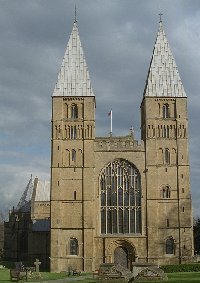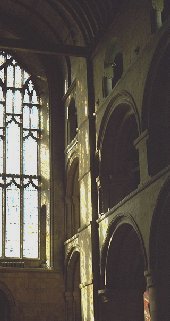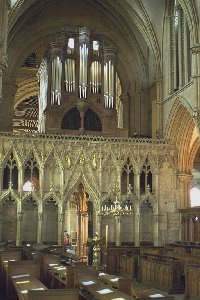
|
Southwell Minster
The Cathedral and Parish Church of St Mary the Virgin, in the diocese of Southwell
History
What is this great mother-church of Nottinghamshire doing here, apparently adrift in the large fields of the county, presiding over its little town? The first known date in the history of Southwell Minster is 956 when King Eadwig gave Southwell and much other land to Oskytel, Archbishop of York. There was a church on the site at that time which contained the tomb of St Eadburgh, a lady saint of the Saxon church. By 1066 a group of priests (not monks) known as a "college" was established here, and it became a collegiate church or minster. These canons or prebendaries had prebendal houses in Southwell and, except for the sacrist, took their name from the villages in which their estates were situated. The office of canon still exists today: there are the residentiary canons who live in the Minster grounds and together with the Dean form the Lesser Chapter. The "honorary" canons who are not residentiary form the Greater Chapter, and the whole Chapter of sixteen canons meets twice yearly in the chapter house. Each canon has his own named seat in the chapter house and in the quire. Our last Rector, Canon Leslie Morley, was the Prebend of Norwell Tertia Pars (there having being two other prebendary manors in the village of Norwell). His seat in the quire is usually occupied by one of the basses when St Peter's Church Choir s invited to sing choral Evensong at the Minster, but graciously he did not insist upon his ancient privilege to occupy that place! The present church, which is mostly Norman, was built by Archbishop Thomas who wrote a letter in the early 12th century asking all of Nottinghamshire to give alms to finance the building of the Church of St Mary of Southwell. Building commenced in about 1108 and was largely complete by 1340. Perhaps because of lack of resources, the church has been little altered since then. It is said that it narrowly escaped destruction during the Civil War. The church remained collegiate until 1841 when it became the parish church of St Mary the Virgin. However, in 1884 the new diocese of Southwell was formed from part of the archdiocese of York and the Minster became its cathedral. The diocese covered the counties of Nottinghamshire and Derbyshire until 1927 when Derby cathedral was consecrated. It now covers Nottinghamshire alone. This makes Southwell the smallest Cathedral City in England (since any town with a cathedral is automatically a city), a small market town some nine miles north-east of Nottingham with many old and interesting buildings. |
Architecture
|
|
|
|
The north porch has a magnificent inner doorway and a 14th century door. Above is a room with a fireplace for the sacristan or his assistant, who slept in the church. The stone screen or pulpitum at the entrance to the quire, built 1320-40, is a luxuriant example of Decorated architecture. The Norman quire was too small to accommodate the vicars choral and choristers, so a new one was built 1234-41, a splendid example of the Early English style with clustered columns having fillets, pointed arches and a profusion of dogtooth ornament. A passage from the north of the quire leads to the Chapter House, an exquisite early Decorated building of about 1290-95. The profuse carvings on the arches and capitals, of trees and plants interwoven with natural and imaginary beasts, are known as the "Leaves of Southwell".
Website |
Return to the History contents page
http://www.stpetersnottingham.org/history/minster.htm
© St Peter's Church, Nottingham
Last revised 4th September 1997
 Is there in England, we wonder, a greater surprise for most of
those who come, for here is the least known Cathedral in our motherland, with a dignity
and beauty unsurpassed. The rushing tide of life has passed it by and left it standing in
a quietude of loveliness, like some dream of time gone by...
Is there in England, we wonder, a greater surprise for most of
those who come, for here is the least known Cathedral in our motherland, with a dignity
and beauty unsurpassed. The rushing tide of life has passed it by and left it standing in
a quietude of loveliness, like some dream of time gone by... The large churchyard is still surrounded by rebuilt
prebendal houses which no longer belong to the church. From the western Norman gateway
with its yews (planted about 1850) there is a fine view of the Minster, built of
cream-coloured magnesium limestone (from Mansfield) which glows in the sunshine. The west
end is the finest surviving Norman west front in England, apart from the large
Perpendicular west window inserted around 1450, and the pyramidal spires of lead (or
"Rhenish caps") which were added much later in 1880. To the south is the
Bishop's Manor built in the ruins of the Archbishop of York's palace. On the north side
behind the transept is the octagonal chapter house. Most of the round-headed Norman
windows are 19th century replacements of large 15th century ones,
inserted to let in more light.
The large churchyard is still surrounded by rebuilt
prebendal houses which no longer belong to the church. From the western Norman gateway
with its yews (planted about 1850) there is a fine view of the Minster, built of
cream-coloured magnesium limestone (from Mansfield) which glows in the sunshine. The west
end is the finest surviving Norman west front in England, apart from the large
Perpendicular west window inserted around 1450, and the pyramidal spires of lead (or
"Rhenish caps") which were added much later in 1880. To the south is the
Bishop's Manor built in the ruins of the Archbishop of York's palace. On the north side
behind the transept is the octagonal chapter house. Most of the round-headed Norman
windows are 19th century replacements of large 15th century ones,
inserted to let in more light. The building of the Norman church to
replace the original Saxon one started at the east end in about 1108, and the nave would
have been reached about 1120-30. The western towers would not have been completed until
after 1150, the north-western one has pointed arches heralding the Early English style.
The west doorway with zig-zag moulding surrounds an original 12th century door
with hinges and ornamental scrollwork of contemporary iron, from which the magnificent Norman
nave may best be seen. The arcades of the nave are in three tiers of half-round
arches, reducing in size as they ascend to the roof.. There are bold round pillars along
the length of the nave with little decoration on their capitals, supporting the smaller
arches of the triforium (upper passage) above which is the clerestory with its round
windows. The whole gives a sense of stability and strength, but also of light and peace.
The wagon timber roof of the nave was made by Ewan Christian in 1880.
The building of the Norman church to
replace the original Saxon one started at the east end in about 1108, and the nave would
have been reached about 1120-30. The western towers would not have been completed until
after 1150, the north-western one has pointed arches heralding the Early English style.
The west doorway with zig-zag moulding surrounds an original 12th century door
with hinges and ornamental scrollwork of contemporary iron, from which the magnificent Norman
nave may best be seen. The arcades of the nave are in three tiers of half-round
arches, reducing in size as they ascend to the roof.. There are bold round pillars along
the length of the nave with little decoration on their capitals, supporting the smaller
arches of the triforium (upper passage) above which is the clerestory with its round
windows. The whole gives a sense of stability and strength, but also of light and peace.
The wagon timber roof of the nave was made by Ewan Christian in 1880. The quire, showing the choir stalls and
the Decorated screen. Behind the organ can be seen the wagon timber roof of the nave.
The quire, showing the choir stalls and
the Decorated screen. Behind the organ can be seen the wagon timber roof of the nave. At the south-east corner are oak leaves and an empty
acorn cup on the capital - below are pigs eating the acorns. High up on the north wall is
a goat eating ivy and the goat-herd blowing his horn.
At the south-east corner are oak leaves and an empty
acorn cup on the capital - below are pigs eating the acorns. High up on the north wall is
a goat eating ivy and the goat-herd blowing his horn.